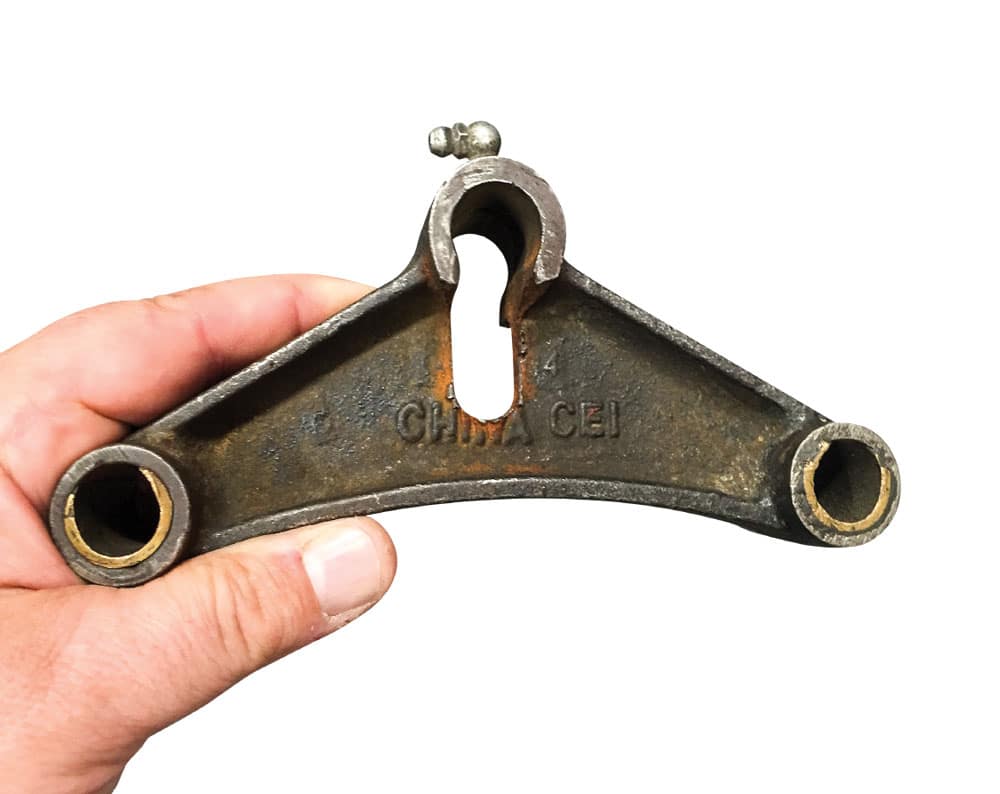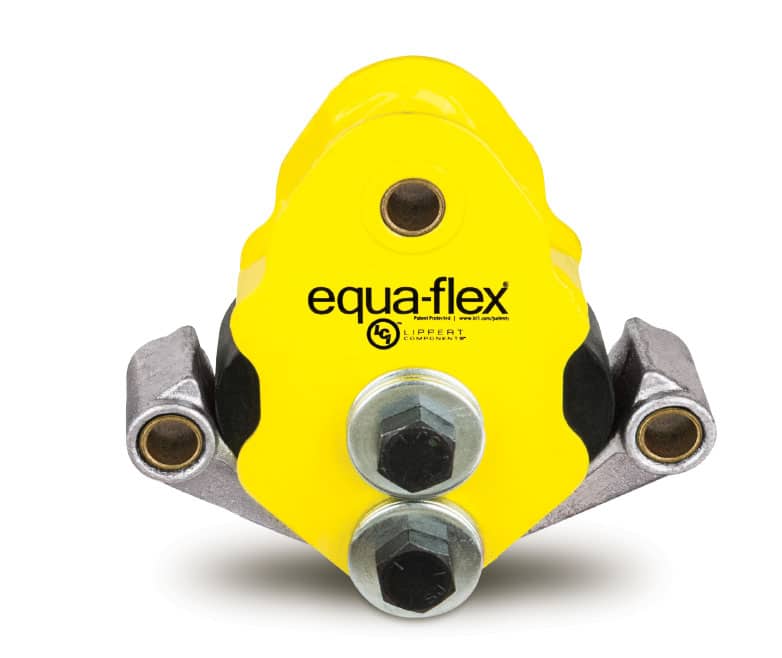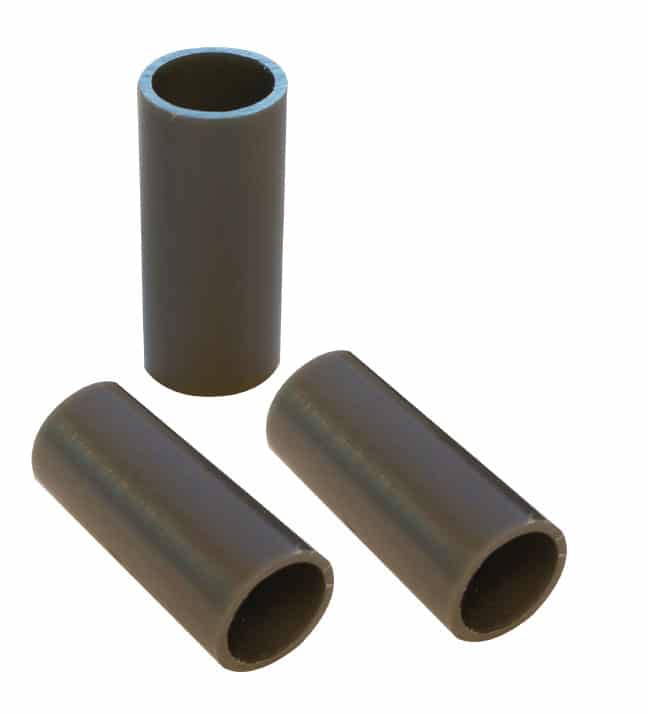A well-maintained suspension system keeps trailers and fifth-wheels rolling down the highway smoothly and safely
When it comes to RV maintenance, the first components that usually come to mind are the roof, batteries and furnace. While trailer and fifth-wheel suspension systems are frequently overlooked, a properly functioning and well-maintained suspension ensures a safe and enjoyable towing experience.
Modern suspension systems serve as attachment points between the trailer’s axle(s) and frame. When traveling over bumps and holes, the suspension system keeps the tires in contact with the road while absorbing and damping the jolting effect road-surface imperfections can cause.
Leaf-Spring Suspension Systems
Most trailer and fifth-wheel suspension systems use leaf springs to cushion the ride because leaf-spring setups are mechanically uncomplicated and inexpensive. Leaf springs have a main spring with eyelets at each end and progressively shorter springs fastened by a center bolt. The length, width, contour, thickness and number of leaves determine how stiff the leaf spring is and how much weight it can support. Leaf springs have been used in suspension systems for centuries, although modern manufacturing techniques have greatly increased their strength and reliability, as well as how smoothly or “softly” they do their job, compared to their medieval ancestors.
On single-axle suspension systems, the leaf spring is attached to the front hanger, which is welded to the frame of the trailer. The rear of the leaf spring is bolted to a spring shackle. A rear hanger connects the shackle to the frame. Leaf springs are designed with an arch, the contour of which is part of the spring design for a specific function. When a leaf spring is placed under a load, the spring flattens somewhat and elongates. The spring shackle allows the spring to move rearward and upward as it compresses.
Tandem-axle and triple-axle suspension systems are somewhat more complicated and use a component called an equalizer to distribute weight between the axles while traveling over bumps and dips. If an equalizer wasn’t used on a tandem system, one axle could be forced to support an excessive amount of weight. In a worst-case scenario, a large bump being traversed by the front axle of a tandem suspension, without an equalizer, could cause the wheels/tires of the rear axle to lift off the ground. Momentarily, the front axle would be supporting the entire weight of the trailer.
Equalizers attach to a central hanger welded to the trailer’s frame. Shackle links and bolts connect the leaf springs to the equalizer and allow the springs to lengthen when compressed. Most trailers and fifth-wheels are equipped with triangle-shaped equalizers made of solid steel.
Shackle bolts, spring eyebolts and equalizer bolts all serve as pivot points in a suspension system. To reduce friction between the bolts and the suspension components, bushings — typically made of nylon — are inserted in the leaf-spring eyes and in the equalizer. Better-quality, higher-cost systems use brass or bronze bushings, and the suspension bolts include zerk fittings so the user can add grease as needed for maintenance.
Torsion-Axle Suspension Systems
A smaller segment of the trailer market uses a different type of suspension without leaf springs. Torsion axles use a steel axle tube that’s square or roughly triangular in shape and an inner steel bar that’s also square or triangular, with three or four rubber “bars” inside the axle tube between the exterior tube and the inner bar. The wheel spindle is mounted to a trailing arm that is fastened to the inner bar. As the trailer weight applies pressure to the trailing arm and moves it up, the inner steel bar “pinches” the inner rubber bars inside the outer tube, and that “pinching” or squeezing pressure is what provides the suspension support and motion.

(Above, from left) Removed from a 2013 travel trailer, these nylon bushings have deteriorated, allowing the shackle bolts to elongate the bolt holes in the shackle plate. A greaseable “wet bolt” has a zerk fitting in the head of the bolt and a channel that allows grease to enter the space between the bolt and bushing. MORryde offers heavy-duty components (top set in right photo) to replace worn stock shackles. The MORryde kit includes thicker shackle plates, bronze bushings and wet bolts.
Rubber torsion suspensions have several advantages over leaf springs. For starters, there is no metal-to-metal contact between moving parts, eliminating the chance of worn metal components. Rubber is used as a spring, creating a smoother ride with less vibration. Torsion-arm axles bolt to the trailer frame, making installation and replacement simpler. And by bolting directly to the frame, a torsion axle acts as a crossmember and adds strength to the trailer frame.
Torsion suspension systems are somewhat more costly, on average, than leaf-spring setups. Unlike leaf springs, torsion systems are true independent suspension systems. Because torsion axles are designed to work independently, they do not provide equalization between the axles when used in a tandem- or triple-axle system.
Inspecting Suspension Systems
There is no set mileage or duration recommendation for RV suspension maintenance, but all of the components should be visually inspected twice a year or every 6,000 miles.
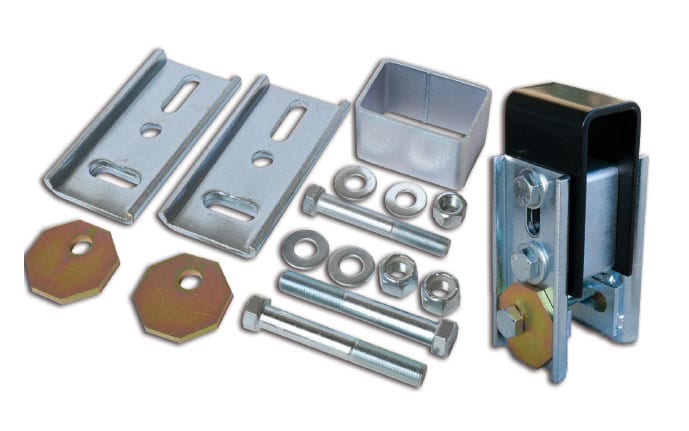
LCI’s Correct Track suspension alignment system’s octagon cam can be adjusted in ¼-inch increments to provide a smoother ride and prevent premature tire wear.
First, do a general examination of the trailer. Does the trailer lean toward one side, or does one tire sit higher in
the wheel well than the others? Are the tires on one side of a tandem suspension the same distance apart as the tires
on the other side of the trailer? Although these conditions might be caused by the contents of the trailer being poorly distributed, they could also indicate broken or worn suspension components. Worn components often move excessively while the trailer or fifth-wheel is being towed, causing clunking, grinding or creaking noises. Trailer sway can also indicate problems with the suspension system.
Leaf springs should be carefully inspected for cracks and breaks. They should also be checked to make sure they have maintained their arch; it is possible for one or more leaf springs to flatten due to wear. Separation of the leaves at the ends of the spring may indicate a weak spring pack and may require replacement. If the springs have a metal spring clip around two or more leaves, verify that the clip is still properly in place. Individual leaves should be checked for bending and misalignment.
Both leaf-spring and torsion axles are manufactured with a slight bend, or camber, causing the center of the axle shaft to be slightly higher than the outer ends. Axles should be visually inspected to verify that the axle tube has not been bent downward due to overloading or striking a curb or pothole.
When examining the axle from under the front or rear of the trailer, the axle tube should appear symmetrical with both sides of the tube sloping slightly upward toward the middle of the axle tube. Placing the center of a straight edge under the center of the axle will help identify a bent axle. The ends of the straight edge should touch the axle tube, while the center should have a slight gap. A string line can also be used. If the axle is bent upward on one or both sides, the axle will need to be straightened or replaced.
All other com- ponents such as hangers, shackle plates and equalizers should be visually inspected for cracking, bending, broken welds and excessive rusting. All bolts should be retorqued to the manufacturer’s recommendations. Spring shackles and equalizer mounting holes in particular are subject to wear because the spring eyebolts rub constantly against these components, and it’s usually a steel-to-steel contact area. It’s not unusual to find elongated holes in the shackle plates or equalizer parts, as well as grooves in the spring eyebolts. Diligent and frequent lubrication can help reduce this kind of wear.
Nylon bushings used in leaf-spring suspensions are subject to wear and should be closely inspected. A worn bushing will cause metal-to-metal contact between the bolt and the suspension component, and may result in premature failure. Because the bushings are inserted in the components, a visual inspection is not possible. The components must be removed for inspection. This requires raising and properly supporting the trailer, followed by removing the shackle bolts, spring eyebolts and equalizer bolts. The bushing, bolts and components can then be inspected for wear. The component bolt holes should be examined for excessive wear and elongation.
Suspension Upgrades
When replacing worn suspension parts, consider upgrading the original components. Suspension upgrades
are available from the original equip-ment manufacturer and aftermarket manufacturers.
A common upgrade is replacing nylon bushings with wet bolts. Wet bolts include brass or bronze bushings and greaseable bolts with built-in zerk fittings. Greaseable bolts allow grease to be injected between the bolt and bushings, reducing wear and increasing longevity. Never Fail bushings from Lippert Components (LCI) are another, less-expensive alternative. They require no lubrication and carry a lifetime warranty.
Equalizer upgrade kits are also available. Some feature rubber dampers that absorb road shock and vibration, improving ride quality and reducing wear. Air-ride equalizers employ air bags to smooth the trailer’s ride.
MORryde International offers complete suspension-system upgrades designed to increase the suspension travel and absorb road bumps. MORryde’s IS system features an independent design that allows each wheel to respond individually to the road. This system is sometimes used as original equipment on larger, higher-end travel trailers and fifth-wheels. Look for a complete installation of MORryde’s SRE4000 suspension system and heavy-duty wet bolt and shackle kit in the March 2017 issue.
Axle Alignment
Just like the tires on a car or truck, tires on trailers and fifth-wheels must be oriented parallel to the trailer’s frame for the trailer to track straight. Worn or broken suspension components, a bent axle or spindle, improper axle installation or an out-of-balance load can contribute to axle misalignment. In some instances, the misalignment might be obvious. A tire that points inward (toe-in) or outward (toe-out), or tires that are too close together on one side of the trailer are indications that the axles are out of alignment or may have been installed improperly at the factory. Measuring the axle-tube to axle-tube distance at each end can determine if they are parallel. Measurements can also be taken to check wheel alignment, but a qualified frame and suspension shop can do this to a finer degree of accuracy.
Premature tire wear is often a sign of trailer axles that are out of alignment. Worn tires that show the worst wear along one edge and progressively less wear toward the other edge indicate a toe-in or toe-out condition. Rapid wear along only one shoulder of the tire is a sign of excessive camber, with the top of the tire tilted away from or toward the trailer frame.
Correcting axle misalignment may be as simple as balancing the load on each axle. When an axle has more weight on one side than the other, the leaf spring on the heavier side will compress and elongate more than the leaf spring on the lighter side, creating an out-of-alignment condition. Correcting the balance will correct the alignment.
In the case of broken or bent suspension components, replacement of the components will be required. However, it might be possible for a trained technician to straighten a bent axle using specialized equipment. Straightening an axle may save a considerable amount of money compared to the cost of replacement.
Some trailers and fifth-wheels come equipped with LCI’s Correct Track trailer-alignment system. Correct Track allows an authorized alignment center to adjust the trailer’s alignment in ¼-inch increments. Precise measurements are taken with a laser alignment tool. After the measurements are recorded, the service technician can adjust the Correct Track octagon cam to properly align the suspension. In the aftermarket, the Correct Track system can be installed on trailers that don’t have the system as original equipment.
Shock Absorbers
Despite their name, shock absorbers do not absorb shock; they are technically oscillation dampers. The purpose of a shock absorber is to damp the suspension movement. When a trailer hits a bump, the suspension is compressed and moves toward the trailer’s frame, absorbing the shock exerted by the road irregularity. The suspension must now release its energy and return to its original position.
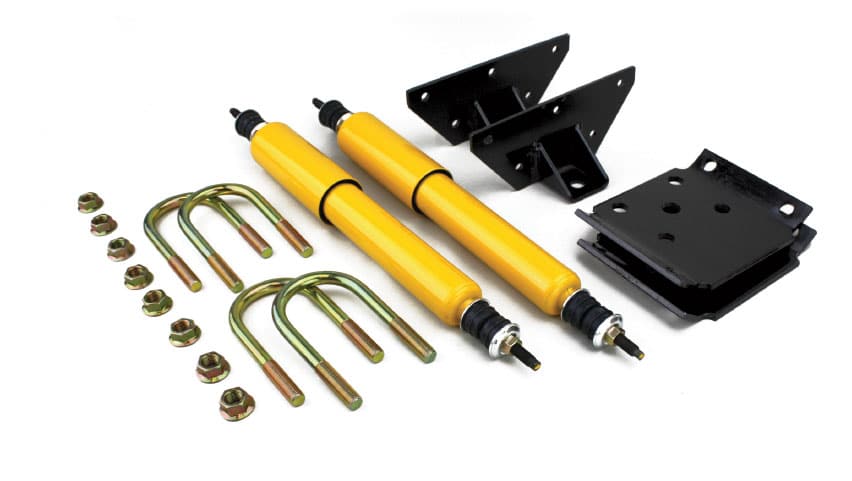
Shock mount kits like this one from LCI provide all the hardware needed to add shock absorbers to a trailer or fifth-wheel.
When the suspension decompresses, it pushes upward on the trailer frame. Gravity then pushes the frame downward, recompressing the suspension. The effect is that the trailer bounces before settling back into a stable towing stance. Anyone who has experienced a failed shock absorber in their car has felt the uncontrolled up-and-down cycling of a spring.
Although shock absorbers play an important role in suspension systems, only a few trailers and fifth-wheels come equipped with them. Even though trailers are not built for passenger comfort, a rough-riding trailer is subject to premature wear and damage to its contents. Fortunately, several manufacturers offer add-on shock-absorber kits, including Dexter Axle, LCI, Monroe and RV Improvement Systems.
Axle-Reversal Kits
Leaf-spring suspension systems come in two configurations. Underslung suspensions are designed with the axle mounted over the leaf springs, while overslung suspensions have the axle mounted under the leaf springs.
Underslung suspensions make the trailer sit a few inches lower to the ground, which helps lower the trailer’s center of gravity and somewhat lessens the effect of wind resistance while traveling. Although a lower stance might be beneficial when traveling on a highway, there are situations when it’s advantageous for a trailer to sit higher, such as when traveling off-pavement or being towed with a tall vehicle. A slightly higher trailer also reduces the chances that low-hanging hardware, such as the dump valves, will be damaged by road obstacles.
Axle-reversal kits, such as Dexter Axle’s Over/Under conversion kit, provide all the hardware necessary to move an axle from over the leaf springs to under the leaf springs. Axle-reversal kits include new spring plates, spring perches and U-bolts. These kits allow the axle to be relocated under the leaf springs while maintaining its camber.
Following a regular schedule of inspection and maintenance will increase the reliability and longevity of any trailer or fifth-wheel. Installing upgraded heavy-duty components will pay dividends through decreased repair bills and less downtime. All of these add up to more miles of trouble-free towing.
Resources
Dexter Axle | 260-636-5311 | www.dexteraxle.com
Joy Rider/RV Improvement Systems | 574-370-4515 | www.rvimprovementsystems.com
Lippert Components (LCI) | 574-535-1125 | www.lci1.com
Monroe Shocks and Struts | 734-384-7809 | www.monroe.com
MORryde International | 74-293-1581 | www.morryde.com

